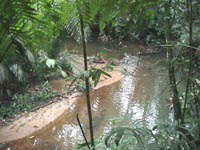 |
|||||||||||||||||||
Today we are leaving the Nantucket Clipper. We will be going to the airport to board a plane that will take us back to California. We have thought about we everything we did, saw, and smelled. We had fun meeting the people that live on the islands, in the rain forests, villages, and cities. We had our favorite parts, too. Wayne liked the dive in the Blue Hole (Day 12) and rappeling into the Black Hole (Day 18). Karen liked working with the dolphins (Day 26) and exploring the Mayan Cave of the Dead (Day 19) During our expedition we learned that even though the coral reefs and rainforests live in different environments (ocean and land) they are alike in many ways. Coral reefs and tropical rainforests are similar because they both: We saw how rainforests and coral reefs are connected. Rivers that flow to the sea carry many things from the rainforests to the corals reefs. Cutting down the rainforests removes the plants that protect the ground from erosion. Rain storms can wash the topsoil into the rivers. The topsoil becomes sediment that the rivers carry out to the sea. In the sea the sediments can cover the corals. This can damage and kill the corals. Rainforests are usually cut down for large scale agriculture. If fertilizers are used for agriculture these fertilizers can also washed into the rivers and out to the coral reefs. These fertilizers can cause algae to quickly grown and cover the corals, killing them. On our 2001 A Sea Odyssey Expedition (Day 6) we saw how algae smothered the coral reefs due to too much fertilizer in the water washed into the sea from the sugar plantations. People are learning how important coral reefs and rainforests are to animals and people. As they learn more about these important natural resources they are doing more to protect them. We were very happy to see how the government of Belize was working to protect the coral reefs along its coast. We were also pleased by the work being done by all the countries we visited (Belize, Guatemala, and Honduras) to make national parks that preserve the rainforests. Even though the places we visited may be thousands of miles from where you live, you can also help protect these special places. You help support organizations that work to protect coral reefs and rainforests. You can collect money by recycling cans and bottles. Use your imagination. You probably have some great ideas you can share with your parents, teachers, and friends. We are sorry we have to leave, but we look forward to next year's Ocean Adventure expedition. We are not exactly sure where we will be going, but we know we will meet some fun and fascinating underwater and some interesting people, too. Check with us after summer break to find out where we will be going next! Best fishes, |
TODAY'S DATA Cayos Cochinos, Honduras Position: 16º 10' N / 86º 24' W
Wayne and Karen get ready to rappel into the bottom of The Black Hole in the Belize rainforest.
In The Cave of the Dead our guide, Marcos, found an ancient Mayan sacrificial knife.This big sharp knife was probably used for sacrificing animals--or even humans!
Flowing through the rainforests are rivers that connect the rainforest to the sea.
Coral reefs are the rainforests of the sea. The coral reefs are a diverse and fascinating ecosystem. Like rainforests, coral reefs are an important natural resource that needs protection. |
||||||||||||||||||
home | basecamp | archives | library other expeditions | kids' page | contact us © 2001, The Ocean Adventure All rights reserved. |
